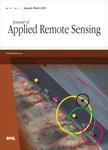版权所有:内蒙古大学图书馆 技术提供:维普资讯• 智图
内蒙古自治区呼和浩特市赛罕区大学西街235号 邮编: 010021

作者机构:Taizhou Pollution Control Technology Center Co. Ltd. Taizhou China Key Laboratory of the Eco-Environmental Big Data of Taizhou Taizhou China
出 版 物:《Journal of Applied Remote Sensing》 (J. Appl. Remote Sens.)
年 卷 期:2025年第19卷第1期
核心收录:
学科分类:07[理学] 08[工学] 0830[工学-环境科学与工程(可授工学、理学、农学学位)] 070207[理学-光学] 0815[工学-水利工程] 0903[农学-农业资源与环境] 0835[工学-软件工程] 0714[理学-统计学(可授理学、经济学学位)] 0825[工学-航空宇航科学与技术] 0803[工学-光学工程] 0701[理学-数学] 0812[工学-计算机科学与技术(可授工学、理学学位)] 0702[理学-物理学]
摘 要:To rapidly and accurately determine the spatial distribution of permanganate index (CODMn) concentrations in surface water, we employed multispectral unmanned aerial vehicle (UAV) remote sensing for water quality inversion monitoring. River extraction was conducted using the normalized difference water index (NDWI) in conjunction with a self-developed parameter a. Fifteen characteristic variables were derived through exponential calculation, and modeling was performed in Jiaobei River using both single-band variables and those with a correlation coefficient exceeding 0.3 and tested in Nanguan River. The model selection included the elastic net regression algorithm, random forest regression algorithm, and gradient boosting regression algorithm. The findings indicated that accurate river extraction is achieved when NDWI exceeds 0.2 and a remains below 0. The gradient boosting regression algorithm proved to be the superior method for constructing an inversion model of CODMn in the Jiaobei River. When applied to the Nanguan River, the model also yielded reliable inversion results. However, in the concentration range of 3 to 5mg/L, the inversion results were less accurate due to an insufficient sample size. A quantitative remote sensing monitoring model of water quality in Taizhou was established using a multispectral UAV, providing technical support for accurate water pollution control. © 2024 Society of Photo-Optical Instrumentation Engineers (SPIE).